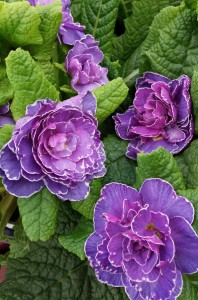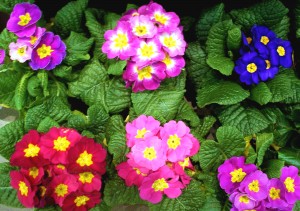Primrose care
Common primrose (Primula vulgaris) also referred to as English primrose belongs to a large family of Primula. It is sold in mass-market grocery and big-box stores for a few dollars. These charming winter/spring blooming plants come in a rainbow of colors and are hard to resist. Because they are realitively inexpensive, I usually buy several plants and combine them in a basket for a big colorful splash. Primrose are considered a grow and throw plant. Once it’s done blooming it is usually thrown out.
The rosette shaped plant with wrinkled leaves, produces a cluster of brightly colored flowers with yellow eyes in the center. Some colors such as dark yellow, orange also have a delicate sweet fragrance.
Care indoors
Keep the plant in bright, indirect sun. Direct sun can scorch the leaves causing dried browned spots.
This blooming houseplant will last longer in cooler temperatures (60F). The soil should be well-drained and evenly moist (not wet) during bloom. Avoid overwatering, do not let the plant sit in water, it can cause root rot resulting in yellowing wilted leaves. Conversely, do not let the plant dry out or the flowers and plant will wilt.
For longer bloom time, remove spent flowers.
Plant tip
When selecting a Primrose plan look for blooms that are just beginning to open and avoid yellow bottom leaves.
Outdoor care
Common primrose is an herbaceous perennial that is hardy in zone 5-8. If you managed to save your houseplant until spring, plant it outdoors in part shade and slightly moist soil. With a little luck, it should bloom the following spring . Common primrose are great in woodland gardens and low growing borders along shaded beds.
Propagation
Divide crowded rosettes every 2-3 years in late spring or after bloom. Start new plants from seed in spring and fall.
Problems
Leaf spot disease and yellowing leaves
spider mites-check for webbing on leaves


Hi,
You see my primrose is wilted and I am quite heartbroken but, nevertheless, I’d like to revive her back to her once healthy state. I’ve had her for a year and her growing and thriving gave me much reassurance (it sounds odd, I know) but, now, she’s wilted.
I’ve tried reading articles and everything but they haven’t told me much, especially since they’re referring to other primroses and not the one I have (of which kind I don’t really know).
Can anyone help me?
I bought a primrose back in March and have kept it even after the bloom ended. It was doing quite well until today…I had begun to notice that some of the older leaves were turning brown, so I trimmed them last night. This morning, the plant was fine. Tonight, however, I noticed that it’s completely wilted. Newer leaves that had been standing straight up have now fallen down. All the leaves are still green and moist, not at all dry. What happened and how do I fix this? (Note- I usually keep it in my kitchen window, where it receives direct sunlight only in the morning. It is next to my mint plant in a separate terra-cotta pot. There is gravel at the bottom and a hole for drainage).
I have a large tree in our front yard with a raised flower bed around it..have planted primroses around it and half of them keep dying..every year I plant new ones, and just like this spring only half of the plants have come up…don’t know what’s going on as they are all treated the same..the only thing I can think of is the ones surviving are on the east side of the tree the others are on the west side…too much sun…???
I bought a cobalt primrose not too long ago from a place that turns out doesn’t take good care of their plants. When I got it home it had two centipedes and a slug on it. It seemed to do better for about a week, then started wilting again. I trimmed the wilted parts off and pulled it out to inspect its roots and I found tiny fast white bugs on the leaves. Please help!
My primroses are not doing well. The new buds tend to dry out after the flowers have faded. Some buds may start blooming but eventually dry out. Please help.
Just moved in to a home with an established garden, with lots of primroses which are looking untidy now that blooming is over. Is it ok to cut off all leaves and allow the plants to regrow next season?
Plant primrose
i have some primrose plants and there is no more blooms on them also they are not planted in a pot or ground. they are still in the small pots you buy them in. should they still be planted and bloom again since its late july? thank you for taking your time to read and answer this, hope to hear soon. treerose.
I just got a primrose plant from a teacher at school to try and revive. This plant is clearly dying. The flowers are withered and are caving into themselves. A lot of the leaves are grey or black and the green ones are drooping and feel a little rubbery. Is there any way to save it?